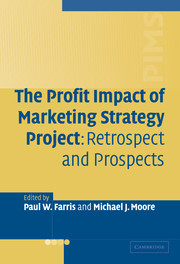Book contents
- Frontmatter
- Contents
- List of figures
- List of tables
- Notes on contributors
- Acknowledgments
- Introduction
- 1 The PIMS project: vision, achievements, and scope of the data
- 2 Putting PIMS into perspective: enduring contributions to strategic questions
- 3 PIMS and COMPUSTAT data: different horses for the same course?
- 4 Order of market entry: empirical results from the PIMS data and future research topics
- 5 Does innovativeness enhance new product success? Insights from a meta-analysis of the evidence
- 6 Marketing costs and prices: an expanded view
- 7 The model by Phillips, Chang, and Buzzell revisited – the effects of unobservable variables
- 8 Causation and components in market share–performance models: the role of identities
- 9 Cargo cult econometrics: specification testing in simultaneous equation marketing models
- 10 PIMS and the market share effect: biased evidence versus fuzzy evidence
- 11 PIMS in the new millennium: how PIMS might be different tomorrow
- Select bibliography
- Author index
- Subject index
- References
11 - PIMS in the new millennium: how PIMS might be different tomorrow
Published online by Cambridge University Press: 22 September 2009
- Frontmatter
- Contents
- List of figures
- List of tables
- Notes on contributors
- Acknowledgments
- Introduction
- 1 The PIMS project: vision, achievements, and scope of the data
- 2 Putting PIMS into perspective: enduring contributions to strategic questions
- 3 PIMS and COMPUSTAT data: different horses for the same course?
- 4 Order of market entry: empirical results from the PIMS data and future research topics
- 5 Does innovativeness enhance new product success? Insights from a meta-analysis of the evidence
- 6 Marketing costs and prices: an expanded view
- 7 The model by Phillips, Chang, and Buzzell revisited – the effects of unobservable variables
- 8 Causation and components in market share–performance models: the role of identities
- 9 Cargo cult econometrics: specification testing in simultaneous equation marketing models
- 10 PIMS and the market share effect: biased evidence versus fuzzy evidence
- 11 PIMS in the new millennium: how PIMS might be different tomorrow
- Select bibliography
- Author index
- Subject index
- References
Summary
From one perspective, the objective of this chapter is to develop a researcher's “wish list” for an idealized dataset to address questions in marketing strategy and elsewhere. From another viewpoint, the topics in this chapter indicate how our field has shifted since the early seventies. In the process of studying “the profit impact of marketing strategy” we have learned that “profit” is not so easily defined and that “strategy” is a somewhat ambiguous term.
While the subject of this chapter is mainly what a revised and revived PIMS project might look like, we should note that PIMS Europe is alive and well. (See Box 11.1 for a brief update of the current PIMS management philosophy.) While PIMS Europe is also open to proposals from academics and others for joint research projects, the organization is clearly more consulting-oriented than either the original PIMS project or what we have in (wishful) mind.
Our final chapter is organized as follows. With the assumption that form and substance will follow function, we begin with a discussion of how the marketing mix has changed. Section 11.1 discusses changes in marketing programs, dimensions of marketing strategy, and the possibilities for defining marketing costs that would be encompassed by a present-day PIMS project. Collectively, these changes have substantially redefined the strategic marketing mix for many companies. Section 11.2 discusses new performance measures that may redefine or augment traditional measures of ROI and ROS, which occupied center stage for the original PIMS project.
- Type
- Chapter
- Information
- The Profit Impact of Marketing Strategy ProjectRetrospect and Prospects, pp. 272 - 286Publisher: Cambridge University PressPrint publication year: 2004

